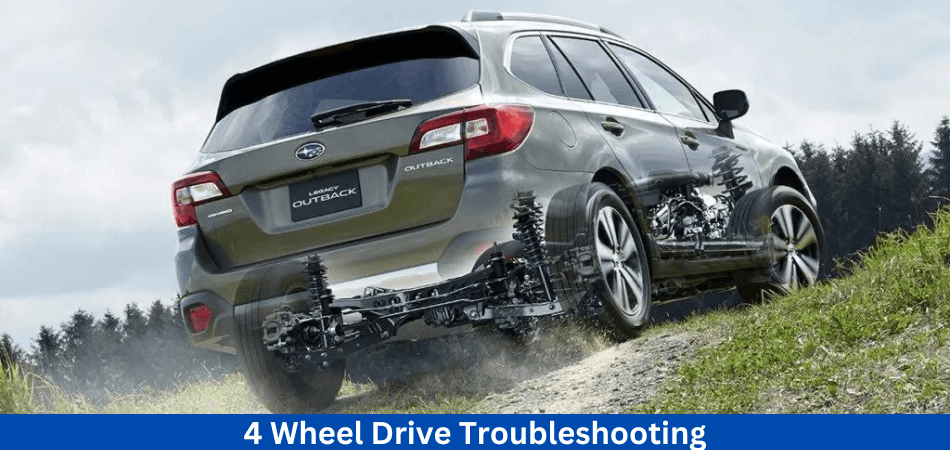
The four-wheel drive is robust, however, there are sometimes niggly issues that require immediate attention. Suppose your four-wheel drive refuses to engage. What is the cause of this and how you can do 4 wheel drive troubleshooting?
Examine the 4WD actuator to see if it is functioning properly. There is a solenoid and electronic switch used in modern 4WDs that need to checked if the 4WD light is blinking on the dash but the system isn’t engaging. Corrosion should checked on all related wires. It is also important to engage your 4WD system once a month to keep it well lubricated.
In the next section of this article, we will explain what an drivetrain is, why we should keep our 4WD system well-lubricated, and how to troubleshoot the transfer case module. You can read more about your 4WD system, including 4 wheel drive troubleshooting.
What Is A Drivetrain?
Drivetrain refers to the mechanism that supplies power to the wheels without including the engine. A vehicle’s drivetrain can designed to send power to either one set of wheels or all four wheels depending on its utility. The following is a detailed explanation of each configuration:
1.Two-wheel Drive (2WD):
A two-wheel-drive system directs engine power only to two wheels. Either the front wheels or the rear wheels can used. The engine of a front-wheel drive car arranged transversely, i.e., perpendicular to the vehicle’s axis. Direct connection of the engine to the front wheels enabled by this layout. Rear-wheel drive cars have their engines arranged longitudinally, meaning they arranged along their axis. Transmissions use driveshafts to connect the engine to the rear wheels.
2. Four-wheel Drive (4WD):
An all-wheel drive system connects the engine to and sends power to all four wheels by combining the FWD and RWD systems in tandem. Four-wheel drive systems can either operate at all times or switch between 2WD and 4WD as needed.
What is a Four-Wheel Drive (4WD)?
Differentials fitted to the front and rear axle assemblies of part-time 4WD systems. Power transferred from the diff to the wheels through the axle. Differentials are the big round bell housings you see underneath trucks, usually on the bottom. In 2H, power transferred to the rear final drive and differential gears through the rear propeller shaft or driveshaft. The system is similar to that of rear-wheel-drive cars with front-mounted engines.
When the vehicle turns left or right, the rear differential gears allow the rear wheels to turn at different speeds. As each wheel continues to receive equal torque.
With 4WD engaged, the transfer case connects the front and rear axles and transmits equal power to the front and rear driveshafts. Each axle assembly transmits the drive to the other.
On slippery, uneven surfaces, 4WD dramatically improves the vehicle’s ability to acquire and maintain traction.
Due to the swiveling of the front wheels, the turning circle is wider than that of the rear wheels, causing a difference in rotational speeds between the two. Thus, the propeller shafts (driveshafts) at the front and rear move at different speeds.
Both axle shafts turn at different speeds due to the difference in speed between the inner and outer wheels. There can also be differences in speed resulting from uneven tire wear between the front and rear wheels or different inflation pressures.
How Four-Wheel Drive (4WD) Works?
In slippery conditions, 4WD dramatically enhances the vehicle’s ability to maintain traction. Because four wheels are better than two, you now have all four clawing for traction and propelling the vehicle forward, regardless of the surface conditions.
The vehicle you are driving has two wheels and is stuck in mud or snow with two wheels. There is no traction on the wheels in the mud/snow and the vehicle cannot propelled forward. The other 2 wheels of a 4WD vehicle will pull the vehicle out since 50% of the power split between the 2 wheels with good traction.
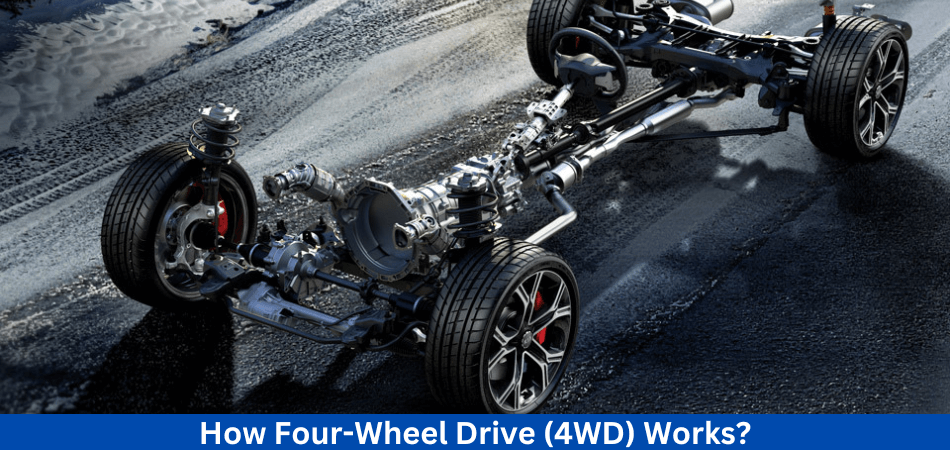
When to Use Four-Wheel Drive (4WD)?
When traction on the surface limited, four-wheel drive should engaged. Our advice is to engage 4WD as soon as the tarmac left behind. Since the rear wheels are pushing and the front wheels are pulling, the vehicle is more stable on slippery roads.
4H Driving in 4×4 mode allows you to drive over and through slippery, low-traction surfaces while maintaining a normal driving speed. These are the ideal 4WD conditions:
- Loose Sand
- Snow roads
- Ice-covered roads
- Gravel roads
- Wet roads
- Slippery low traction surfaces
- Muddy tracks
What Types of Four-Wheel Drive (4WD) Are There?
1. All-Wheel-Drive (AWD)
A Providing power to all four wheels of a vehicle through a front, rear, and center differential.
2. Part-Time-AWD
Until traction lost, part-time all-wheel drives operate like front-wheel drives. As a result, power will automatically sent to the rear wheels to maintain traction.
3. Part-Time 4WD
Drivers can select the best drivetrain mode for specific driving conditions by switching on and selecting 4DW.
4. Full-Time-4WD
Throughout all terrains, power is continuously delivered to all four wheels.
Advancements In Four-Wheel Drive (4WD) System
Electronics and differential design play a major role in any advancements in the 4WD system.
In order to overcome the disadvantage of simple differentials: the loss of power at the wheel with the least traction, locking and limited-slip differentials developed. A variety of vehicle types equipped with partial 4WD, full-time 4WD, or all-wheel drive systems.
Electronic actuation and sensor technology have eliminated the need for manual engagement of 4WD systems by locking differentials and driveshafts. Based on the terrain, the vehicle’s onboard computer selects the most optimum settings, so the driver doesn’t have to worry about anything.
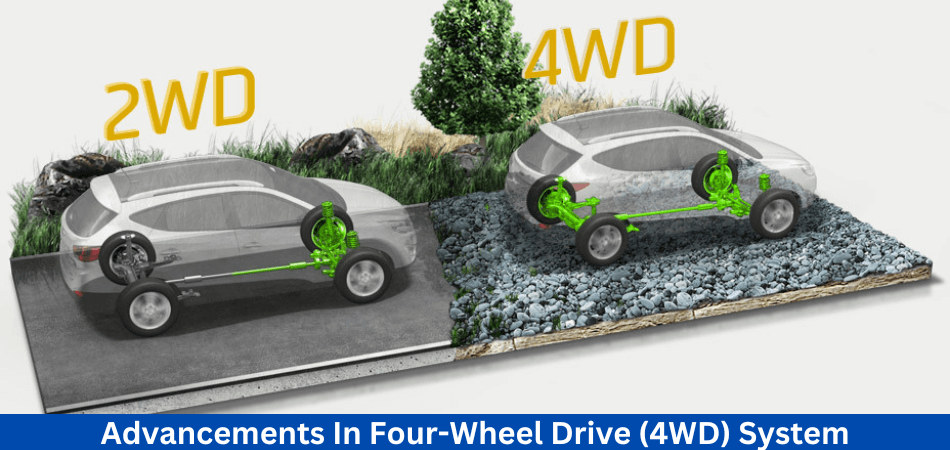
What are the Pros And Cons Of A Four-Wheel Drive (4WD) System?
Four-Wheel Drive (4WD) Advantages
- Power and traction are the main benefits of 4WD. Have you ever seen those Jeep commercials where it climbs boulders and rocks? Here’s an example of 4WD in action.
- If For climbing steep hills or off-roading, you will need more power to get over obstacles and climb steep hills. You may not need 4WD if you are off-roading, but 2WD will get you over even the steepest San Francisco hills.
- 4WD improves traction in difficult driving conditions, such as snow, ice, rocks, and other situations. Traction and control improved when both sets of wheels engaged.
- A heavier vehicle has a better grip on the road due to its increased weight.
- If you enjoy off-roading, 4WD is a great choice.
- A four-wheel drive will greatly benefit you if you frequently drive in low-traction conditions or enjoy off-roading.
Four-Wheel Drive (4WD) Disadvantages
- In It is not necessary to use 4WD in most cases. This increases fuel consumption and leads to overconfidence, resulting in more situations where you can get stuck. Using 4WD only when necessary will save you money and fuel.
- The main disadvantage of 4WD is the added cost of purchase, maintenance, and fuel. Additional equipment (differentials, transfer cases, etc.) increases the initial market value, tire wear, and repair and maintenance costs of the vehicle.
- Compared to 2WD systems, 4WD and AWD systems use more fuel because of their added power and weight.
- As weight added, traction and control improved, but stopping distance increases. The lighter the vehicle, the easier it is to avoid a collision.
- It is common for drivers to become overconfident in 4WD and AWD, which, ironically, leads to more situations in which they become stuck.
- Even though 4WD provides better traction, you should take extra care on slick, icy, or snowy roads. A dangerous accident can result from overconfidence.
What Are The Benefits Of A Four-Wheel Drive (4WD)?
There are many benefits of having a car that is 4-wheel drive including-
1. Elevated driving position
The 4-wheel drive might be the right choice for you if you prefer to drive your car higher off the ground. A higher driving position gives you better visibility on the road, and makes accessibility easier, and people often feel a greater sense of safety.
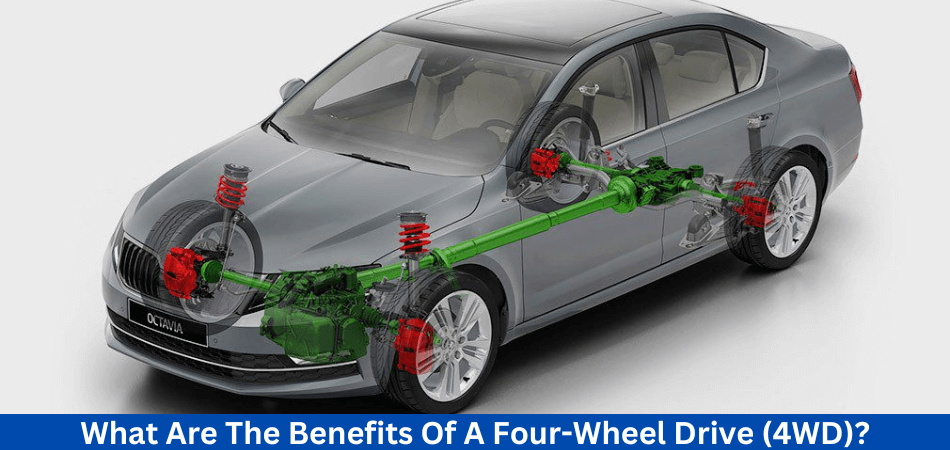
2. Off-roading
Offroading is exactly what 4-wheel-drives designed for. Your 4×4 is capable of handling tricky terrain that most struggle with when out and about. An adventurer’s dream, this vehicle is a great choice. It’s safe to pack up your camping and hiking gear knowing your car can handle it.
3. Towing
If you need to tow when you’re out and about, your 4×4 has got you covered. In addition to its 1700-kg towing capacity, the Skoda Kodiq can tow a maximum of 2000kg! Before you set off, make sure you know your vehicle’s weight limits so that anything you’re towing doesn’t exceed 85% of the vehicle’s towing capacity.
4. Space & Storage
Choosing a 4-wheel drive might be the best choice if you value interior space when looking for a new car. Likewise, 4x4s have adjustable and removable seating, and their elevated height makes getting in and out super easy. This also means less back-breaking work when installing child seats if you have children.
What are the Problems With Four-Wheel Drive (4WD)?
The convenience of having 4-wheel drive when you need it most is obvious to anyone who owns a 4-wheel drive vehicle. You can rely on your 4WD to save the day, regardless of whether you enjoy regular adventures or find yourself in a tricky spot. However, you should understand that problems can arise from time to time with any vehicle part. Therefore you might need sometimes 4 Wheel Drive Troubleshooting.
1. Indicator Issues And Signaling Problems
You’ll notice an indicator light on your dashboard displaying inaccurate information when your 4WD system doesn’t engage properly. The problem needs to corrected by a qualified mechanic. It is possible that the gear hasn’t been completely shifted if the indicator light blinks constantly.
2. 4WD Stuck
It is possible for older 4WD vehicles to remain in 4WD mode while their engines are running. This will result in a constant blinking of the indicator light. It is usually possible to resolve this problem by shutting off the vehicle’s engine and starting it again. Driving in reverse for 12 feet is another option. In order to disengage the 4WD, you must shift to drive. The final option, if none of the above methods are successful, is to run your vehicle in low gear. Put your car in two-wheel drive before turning it off while you’re driving. A skilled mechanic will needed if nothing helps.
3. Shifter Fork Damage
During the transfer shift work, the lever moved from 4WD to normal drive. It is possible for the shifter fork to become damaged due to the great amount of pressure, which will cause the system to slip from normal to 4WD. A professional will need to replace the damaged or faulty shifter fork.
4. Problems With The Chassis
After experiencing a few adventures, your 4WD vehicle is likely to have encountered some rough terrain. As a result of this kind of use, the chassis can crack, and rust can also develop due to rain and moisture. It is important to address rust sooner rather than later to minimize damage. It’s a good idea to ask about rubberizing solutions after cleaning and repairing the problem area if necessary.
5. Suspension Problems
When you drive your 4WD vehicle on hard roads regularly, the suspension can also suffer. A mechanical problem can result in chassis damage, so you should always be on the lookout for it. Among the parts that should inspected regularly are nuts and bolts, the steering rack, and your shocks. You will feel those bumps if you have worn or damaged shocks! Furthermore, faulty shocks compromise your vehicle’s traction. The worse your shocks, the more your vehicle bounces and the less it sticks to the road.
Wear and tear are inevitable, but you can make sure that you inspect your vehicle and watch out for signs of trouble. Additionally, you can enjoy peace of mind and coverage by choosing the right extended warranty for your 4WD vehicle.
6. Unresponsive 4wd System
Often, an unresponsive 4WD system caused by a faulty 4WD switch. In spite of differences in car makes and models, the basic functionality of a 4×4 system is often the same. The 4WD actuator locks the vehicle’s front and rear differentials together when the four-wheel drive mode selected. By doing this, both axles rotate together in uniform motion, bringing all four wheels into motion at the same time.
An actuator can delayed or not respond correctly if the 4+4 switch malfunctions. As a result, the 4WD system also fails. Faulty 4WD switch systems characterized by this symptom. Vehicles may also become stuck in 4WD mode as a result of this problem.
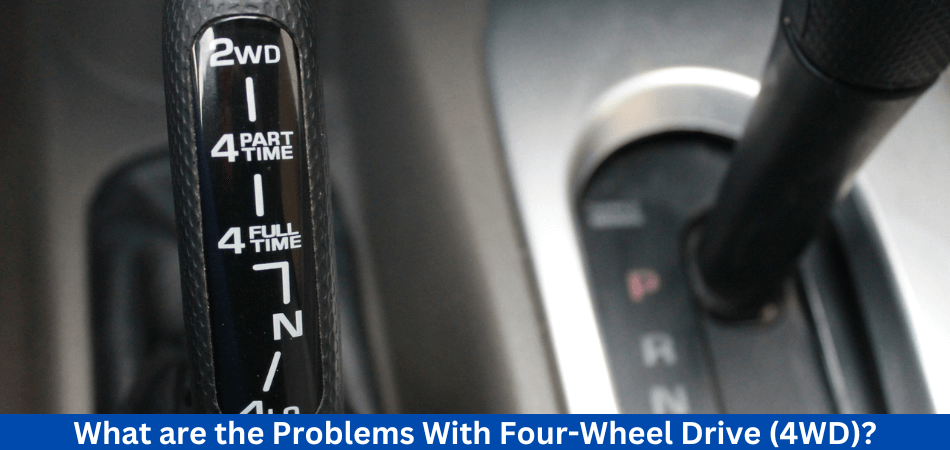
7. Lights Flashing On The Dashboard
Indicators for 4WD modes are typically found on dashboards of cars equipped with four-wheel drive systems. In the event of a malfunctioning 4WD transfer switch, the indicator light may flash or blink continuously.
There are also other underlying problems that can cause the 4WD indicator to flash on the dashboard. To ensure vehicle safety and proper maintenance, a driver should be familiar with all dashboard warning lights.
8. Repetitive Disengaging From 4wd Mode
It is also indicative of a failing 4×4 switch if the car repeatedly disengages from 4WD mode without any input. In order to accurately diagnose and resolve a problem with a bad 4WD switch, it is important to monitor these common symptoms.
4 Wheel Drive Troubleshooting: How to Fix Your Faulty Four-Wheel Drive (4WD)?
Wondering about 4 Wheel Drive Troubleshooting. You might face the above mentioned problems that will require 4 Wheel Drive Troubleshooting. Here are the troubleshooting tips for you.
1. Engagement Issues:
Be sure you follow the instructions in your vehicle’s manual when engaging and disengaging 4WD. The transfer case shift linkage or electronic controls may need to lubricated or replaced if problems persist.
2. Strange Noises:
For any damaged or worn components, inspect the differentials, axles, and transfer case. Parts should replaced or repaired as necessary. Noises that are unusual may indicate problems with the gearsets, bearings, or seals.
3. Vibration or Shaking:
Make sure that the driveshafts, u-joints, and CV joints are in good condition. If any components worn or damaged, they need to replaced in order to prevent vibrations or shaking. Make sure the tires balanced and in good condition as well.
4. 4WD Not Working:
If the 4WD doesn’t engage at all, make sure the transfer case, the front axle, and the differential are not damaged. Ensure that there is no leak or blockage in the vacuum lines (if applicable). Any damaged components should repaired or replaced. A diagnostic scanner should used to diagnose and fix electrical problems.
5. 4WD Warning Light On:
Read the error codes stored in the vehicle’s computer using a diagnostic scanner. It is possible to pinpoint the problem by looking at these codes. Electrical problems, sensor malfunctions, or problems with the 4WD actuator could be the cause. According to the error code, resolve the specific issue.
6. Fluid Leaks:
Locate the source of the leak, which may be the transfer case, differential, or axle seals. Replace or repair damaged seals or gaskets. Be sure to use the correct type and amount of fluid when refilling.
7. Difficulty in 4WD Engagement:
If you have trouble engaging 4WD, try driving forward or backward a short distance to help the components mesh. Ensure that your vehicle is on a flat surface. Consult your vehicle’s manual for specific engagement instructions if problems persist.
8. Regular Maintenance:
The importance of preventative maintenance for 4WD systems cannot overstated. Inspect and grease components, change fluids, and check for signs of wear according to the manufacturer’s recommended maintenance schedule.
4 Wheel Drive Troubleshooting – Information Messages
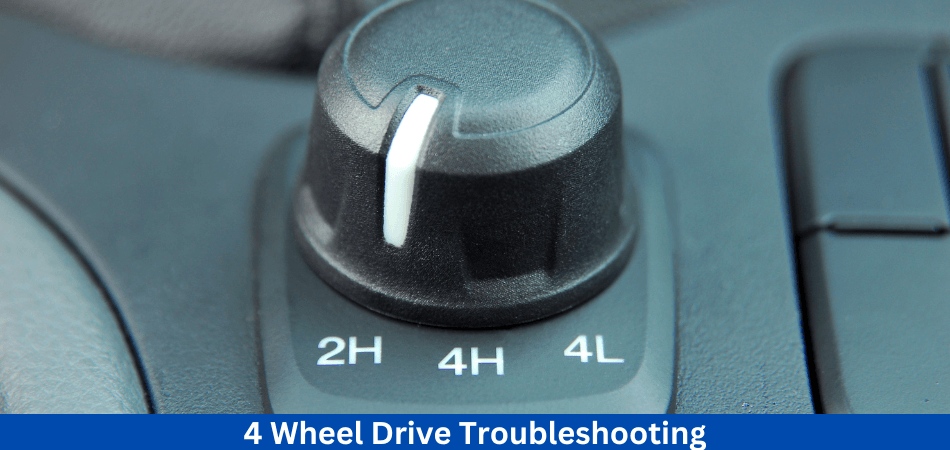
- For 4L slow to a stop: Activates when driving too fast and trying to switch to four-wheel drive low.
- For 4L Shift to N: Shows when the driver attempts to shift into four-wheel drive low without the transmission in neutral (N).
- For 4L press Clutch: Signals when the clutch pedal is not pressed when shifting into four-wheel drive low.
- To exit 4L slow to a stop: Activates when the driver tries to shift out of low-range four-wheel drive.
- To Exit 4L Shift to N: Displays when shifting out of four-wheel drive low without the transmission in neutral (N).
- To exit 4L Press Clutch: Displays when the clutch pedal is not pressed when shifting out of four-wheel drive low.
- 4×4 Shift in Progress: Shows whether the four-wheel drive system is shifting into or out of two-wheel drive high.
- 4X4 Temporarily Locked: Signals a situation in which more four-wheel drive performance is temporarily required. Once these driving conditions are no longer detected, the system resumes normal operation.
- 4×4 Temporarily Disabled: Displays when the four-wheel system detects elevated temperatures and temporarily disables the front wheels. Upon returning to normal system temperature, the system resumes normal operation.
- 4×4 Restored: Indicates when the four-wheel drive system has restored to normal operation.
- Shift Delayed Drive Forward: Indicates a shift cannot completed and forward motion required.
- 4×4 OFF: The system disabled when the tires mismatched or there is an external problem.
- Neutral Tow Enabled Leave Transmission in Neutral: This display indicates whether neutral towing has been successfully engaged.
- Neutral Tow Disabled: Indicates that neutral tow mode has disengaged successfully.
How to Maintain the Four-Wheel Drive (4WD)?
Keeping your 4WD system (Four-Wheel Drive) maintained will ensure its reliability and safety. For your 4WD vehicle, here is a maintenance checklist:
1. Regular Inspections:
Make sure the 4WD system is regularly inspected for visible damage, loose or worn components, or leaks. Ensure that driveshafts, u-joints, differentials, and axles are in good condition.
2. Fluid Changes:
Change the fluids in the transfer case, front and rear differentials, and manual locking hubs (if applicable) according to the manufacturer’s recommendations. Fluids should used according to their specifications.
3. Greasing:
The u-joints, CV joints, and any other grease fittings should lubricated as necessary. Vibration minimized and wear reduced with proper lubrication.
4. Tire Maintenance:
Make sure your tires are properly inflated and rotated on a regular basis. Tire treads that are excessively worn should replaced.
5. Alignment:
Make sure your 4WD vehicle aligned regularly. Uneven tire wear and handling problems can result from misalignment.
6. Brake System:
Make sure your vehicle’s brake system maintained, including brake pads, rotors, calipers, and brake lines. Off-road and on-road safety depend on properly functioning brakes.
7. Suspension Components:
Replace worn suspension components such as bushings, shocks, and struts as necessary. Proper handling and ride quality ensured by a well-maintained suspension system.
8. Electrical Components:
The electrical components of your 4WD system, including switches, sensors, and the 4WD control module, should inspected and tested. Any malfunctioning parts should replaced as soon as possible.
9. Air Filters:
Clean air is essential for optimal engine performance, so make sure the air filter replaced regularly. Fuel efficiency and power can reduced by dirty air filters.
10. Battery:
Make sure the battery is securely mounted and that the terminals are not corroded. Be prepared for winter weather, as cold temperatures can strain batteries.
11. Exhaust System:
The exhaust system consists offhaust system for leaks, rust, or damage. Engine performance and fuel efficiency can reduced by a damaged exhaust system.
12. Off-Road Driving Maintenance:
If you frequently use your 4WD vehicle off-road, you should be especially diligent about maintaining it. After off-road excursions, clean the mud and debris from under the vehicle and inspect the undercarriage for damage.
Conclusion: 4 Wheel Drive Troubleshooting
Now you might have some idea of 4 Wheel Drive Troubleshooting. Engaging your 4WD system periodically is a valuable exercise. It will not necessarily prevent your 4WD components from packing up, but it will alert you beforehand if it does. Lubrication-wise, this is an excellent exercise for keeping 4×4 drivetrain components well lubricated and protected from moisture build-up inside differentials. To prevent corrosion, inspect all electrical cables to vital 4WD components and spray them with a good silicone spray.
Check smallest items first, such as dashboard switches, wires, connections, lubrication levels, and then electronic components and the diff actuator switch when troubleshooting.
Read more of our articles here.
FAQs
What is causing my 4WD to not engage?
This issue can be caused by several factors, including a faulty transfer case, a broken drive shaft, or an electrical problem. Having it diagnosed by a mechanic is essential.
What is the best way to tell if my 4WD is engaged?
When 4WD is engaged, an indicator light appears on the dashboard. It can also be tested by driving slowly on a loose surface (such as gravel) and feeling if all four wheels are pulling.
What does a blinking or flashing 4WD light mean?
4WD lights blinking often indicate a problem with the system. Possibly, the transfer case has low fluid levels, or there is a sensor issue.
Is it possible to switch my 4WD on and off while driving?
It depends on the 4WD system in your vehicle. While some can be shifted on the fly, others require stopping and shifting into 4WD.
How do I get my 4WD out of 4WD mode?
If In case you are unable to shift out of 4WD, try stopping, shifting into neutral, and then shifting back into 2WD. Consult your vehicle’s manual or a mechanic if that doesn’t help.







Leave a Reply